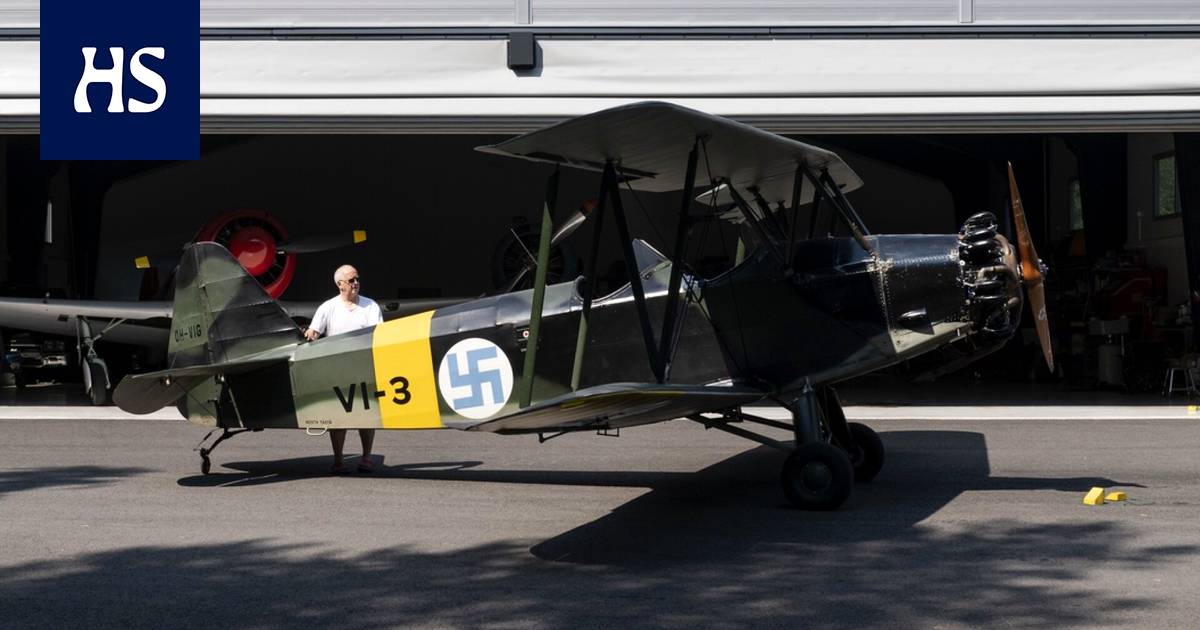Phillip Lawton from Espoo owns a Finnish and Soviet school plane from the Second World War. Museum-aged machines take a lot of time and a considerable amount of money.
Recreational vehicle one after another drive to Räyskälä airport in Lope. There is a large white tent in the middle of the runways, and on each side of the field there are poles with loud speakers attached to the ground.
Finland’s biggest religious event, the Summer Societies of the Lestadians, is about to begin.
Families get out of camper vans, and a group of young boys go exploring the surroundings.
At the back of the field, in front of the hangar, something unexpected stands: a red and white propeller plane that seems to have come from somewhere decades ago.
One of the boys exclaims in surprise, and the others’ heads turn. For a moment the young men stare at the plane and then continue their journey.
But what would have been the boys’ reaction if they had seen the plane inside the hangar with swastikas painted on its sides and wings?
Lawton’s Jak-11 was manufactured in Czechoslovakia, where it was sold to the Egyptian Air Force. The plane was abandoned in the desert until a French businessman found and restored it.
Red and white the plane is a Soviet-made Jak-11 school plane from the late 1940s. It is familiar to many people interested in aviation, because Jak flew in the summer of 2021 at the Kaivopuisto air show.
It may have been the first time in nearly 80 years that a Russian military plane flew over southern Helsinki with red stars on its wings.
Now the stars are no longer visible on the wings.
“When Russia attacked Ukraine, I painted the red stars to hide. They no longer felt appropriate,” says the machine’s owner Phillip Lawton.
Phillip Lawton at the controls of the Jak-11. The plane’s flight speed is 600 kilometers per hour. 180 liters of fuel are consumed per hour.
Lawton, 67, who lives in northern Espoo, enjoys old airplanes. In addition to Jak, he has a Finnish-made Viima school plane from the late 1930s – the very one with swastikas on its wings.
The swastika on the plane evokes emotions, but Lawton is surprised that he still has to explain the background of the symbol to Finns as well. The swastika was the emblem of the Finnish Air Force even before Adolf Hitler adopted it as a symbol of his Nazi party.
“Viima has historically had the right colors and emblems, so I’m not going to change them.”
Phillip Lawton takes off an old pilot’s helmet. The Viima school machine that he bought in 2015 can be seen in the background.
For Lawton old airplanes are not just collectibles. He flies his planes and also spends a considerable amount of work and time maintaining them.
Lawton has rented a hall for his machines in Räyskälä and even bought a summer house a kilometer away to make it easier to practice.
However, the summer clubs have caused the British to not be able to fly their planes for two to three weeks.
On the other hand, Lawton has Suviseuroi to thank for having an airplane hangar for his planes. When the Summer Clubs were organized on the Räyskälä field ten years ago, the hall was built as a restaurant for the event.
Read more: Here, the talking is done by a man – 76,000 people gather for a religious giant event in the middle of nothing
Phillip Lawton became a resident of Espoo in 2008.
by Phillip Lawton his interest in airplanes dates back to his childhood, but he did not grasp the controls of an airplane until quite late in life.
“I passed my pilot’s license in 1992, and at first I flew ordinary planes. Then I became interested in aerobatics and got a suitable airplane for it.”
Lawton was a successful entrepreneur. He had founded an engineering office with his brother, which eventually grew into a company of 110 people. Then the brothers got bored.
“We noticed that the work was no longer fun. We sold the company in 2005, and I retired at the age of 49.”
However, the leisurely days of retirement did not last long. His aerobatic plane had been serviced and repaired at a company in Thruxton, England, which also restores old planes.
During one visit to the workshop, Lawton saw two legendary British WWII fighters, the Hawker Hurricane and the Supermarine Spitfire.
“I was immediately sold. I wanted such a machine for myself.”
The opportunity came quickly. The aircraft repair shop went bankrupt, and Lawton bought the operation for himself. He began restoring old machines and selling them to collectors.
Viima machine in front of the airplane hangar rented by Phillip Lawton at Räyskälä airport.
Lawton moved to Espoo in 2008. The reason is the most common: his wife is Finnish.
Living in Finland was also a big help when Lawton built himself an airworthy plane from two Hurricane scraps in Thruxton.
The Finnish Air Force Museum in Tikkakoski has one restored Hurricane from the Continuation War, and Lawton received drawings and loaned parts from the museum to make copies of.
“That’s why I decided to paint the plane in the colors of the Finnish Air Force from the war and bring it to Finland for air shows.”
In 2014, Lawton’s Hurricane flew at aviation events organized at both Malmi and Oulu airports.
Soon after, Lawton became a pensioner again. A wealthy German collector came to Thruxton and wanted to buy all of the company’s aircraft, facilities and tools.
“The German asked what amount I would sell for. I said a very large number. He paid it without hesitation and bought me out of business.”
Read more and watch the video: The engineer’s great work landed in Malmi – a British man flew to Finland a copy of the Hurricane aircraft used in the Continuation War
Phillip Lawton’s Hurricane fighter jet at Malmi Airport on August 7, 2014.
Lawton’s owned by Viima is quite significant in aviation history, as it is the first series-produced VL Viima.
In addition, Viima was the first type of machine that was designed and built domestically.
“I asked the Aviation Museum what would be the type of plane that should be brought to Finland. They said Viima, so I decided to get one.”
The problem was finding an ancient machine somewhere. Lawton got a tip from his British friend that one Viima could be found in Germany.
The plane in question had come a long way since the Air Force had abandoned it in the 1960s. At first it had towed sailplanes but was then sold to England. There, the plane ended up in a war film that premiered in 1976 Aces High.
“Viima was painted red and represented a German plane. It appears in the film for seven seconds.”
From England, the plane had been sold to a museum in Belgium, and from there again to Germany, where Lawton bought the plane.
VL Viima is a slow aircraft. Its stated top speed is only 186 kilometers per hour.
Lawton bought and restored Viima because he thinks that museum planes should be able to fly. However, the perception differs from the way of thinking of Finnish aviation museums.
“I wanted to start a new way of seeing old planes in Finland, but here in the museums they are of the opinion that they should never fly.”
The reason for the scarcity of Finnish museums may well be money. Keeping museum-age planes airworthy is an expensive endeavor.
According to Lawton, keeping the Jak-11 and Viima in flight condition costs 10,000 euros per year per plane, and that does not even include spare parts.
“Recently, spare parts don’t even exist, but you always have to get a new one to replace the broken one.”
Viima’s engine must be serviced after ten flight hours. One maintenance takes six hours.
One the purchase price of a historic machine is at least hundreds of thousands of euros. According to Lawton, Jakin can be had for 300,000 euros, but to those who ask Viima’s price, he answers: “You can’t afford it.”
On the other hand, old machines retain their value if you ever want to sell one. The same cannot be said for, say, a Ferrari, whose price is suddenly half of the original.
Still, owning a shiny new Italian sports car suddenly makes more sense than owning a 90-year-old airplane.
Swallowing euros Lawton knows how to approach his hobby with a twinkle in his eye.
“It’s a stupid, ridiculous hobby and a good way to lose money,” Lawton says with a grin.
However, not everything is measured in money.
“I once sent a picture I took of the hangar and the machines to my daughter in England, and she replied: ‘Ah, so you are in your lucky place.'”
Read more: A mysterious plane crash took place in Espoo almost 80 years ago – Why did the Germans fly with an empty tank in the winter sky?
Phillip Lawton in the cockpit of the Yak-11. The noise while flying is so loud that Lawton wears both earplugs and hearing protection.
#Espoo #Briton #Phillip #Lawton #burns #fortune #flying #plane #swastikas #skies #Finland #change









